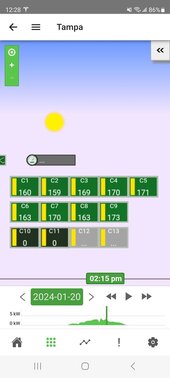Disconnect
- Bad connection (b/c the 1kHz or 20kHz, whatever it is, could well be going down the whole wire, it will not be limited by distance)
- Some component is resonating (wires can't do that but maybe there are things in the SPDs that can do it)
- (unlikely) sound conduction from the distant array, this will fall off by distance
Panels:
- plenty of active components and things that can resonate, inside the optimizers.
- the solar panels are just wires and cells, so probably less likely than the optimizers
All that said, I think divide and conquer , check all junctions, is way more productive than trying to think of root causes (root cause = shot in the dark given the limited amount of data available, divide and conquer / other diagnosis steps will get more data). I mean I know there's not much that can be done at this hour, sitting in front of a keyboard. But even still writing down the plan for how to divide and conquer diagnosis this is more productive than randomly throwing out root causes.




